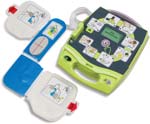
September 2009
- INCENTIVES: The Power of Positive Reinforcement
- SHOWERS & EYEWASH: Joining Emergency Care and Hydration
- SLIP & FALL SAFETY: Six Essential Elements
- DEFIBRILLATORS & CPR: Use the Tools You Already Have
Click here to subscribe.
Cover Story

By Duane A. Perkinson
Vision issues are safety concerns when an employee cannot see his work because of an incorrect prescription, improper lighting, effects of dry eye, or age-related factors. As an eye care professional, I have worked with prescription PPE for the past 30 years and recommended to my clients they establish a comprehensive vision policy for their workforce.
Features
By Bruce Pettengill
Every day, an estimated 1,200 eye injuries occur in the workplace, and about 120,000 of these injuries per year are disabling. Thousands of people are blinded each year from work-related eye injuries that could have been prevented with the proper selection and use of eye and face protection.

By Marc Barrera
Since its start in 1913 as the National Council for Industrial Safety, the National Safety Council has weathered its share of storms. In 1941, it answered the call from President Franklin D. Roosevelt to "mobilize its nationwide resources in leading a concerted and intensified campaign against accidents, and to call upon every citizen, in public or private capacity, to enlist in this campaign and do his part in preventing wastage of human and material resources of the nation through accidents."

By Michael Fraley
The path to floor safety is often obstructed by procedures
and ideas that tend to focus on the overall safety
program of a facility, with floor safety being only
one component of that safety program.

By Michael E. Bingham
As a certified First Aid/CPR/AED instructor, I've trained many, many people during the past few years. I've learned a great deal from those I've trained, as well. As a certified EMT—Intermediate and former first responder for the local fire department, I've assisted in some cardiac emergencies and have learned a lot there, too.

By Rob Wolff, Mike Markovsky
Workplace safety is a major concern of every employer — more now than ever before. Through the years, stringent regulation and an ever-growing concern for the health and well-being of employees have brought advancements in processes, safety procedures, and first aid protocols to treat the injured. This movement has had a profound impact on emergency equipment, including eye irrigation and personal hydration.
By Shah Khajeh Najafi, Dyron Hamlin
A chemical emitted from an individual site and the effect of that release — on not only the emitting site, but also on neighboring sites and nearby communities — are of concern to plant personnel, community leaders, and regulators.
By Doug Hamilton
It is generally accepted that around 80 to 85 percent of workplace "accidents" are traceable to some specific human behavior, either at the time of the accident or preceding it. Therefore, to achieve improvement, it is necessary to understand the root cause(s) of the unsafe behavior taking place and how that behavior can be replaced by new, safe behavior.
Departments
By Jerry Laws
Today's Marylanders aren't playing enough tennis or engaging in other kinds of exercise, but that's true across the board. CDC reported July 8 that the percentage of U.S. adults who are obese increased to 26.1 percent in 2008 from 25.6 percent in 2007.

By Marc Barrera
Like clockwork, the start of each day in the office usually involves reading through at least 30 new e-mails. Among that electronic clutter, only five to six items are original, followed by numerous replies back and forth between everyone addressed. Getting up-to-date on each e-mail is a tricky proposition that often results in the accidental deletion of a reply here and there.
By Robert Pater
Interested in propelling stronger safety culture? Quantum Physics proclaims energy moves both in waves of motion and as individual particles.